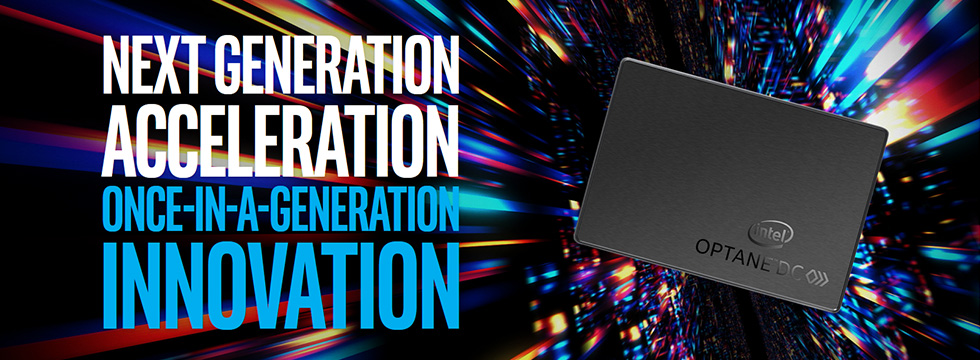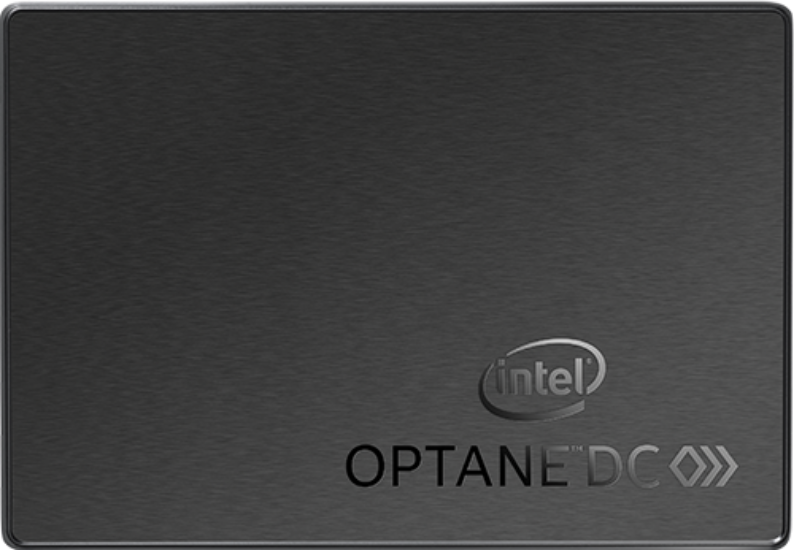
Your Most Demanding Storage And Memory Challenges Solved
The world is creating massive amounts of data at explosive speeds. Until now, storage technologies have not been able to keep up. The Intel® Optane™ SSD DC P4800X combines the best of two worlds—storage and memory—to create an unprecedented solution. And while the Intel Optane SSD P4800X looks like any other SSD, it’s backed by Intel® Optane™ technology. This unique architecture gives it a faster and more consistent edge over its NAND-based counterparts.
| |||||||||||||||||||||||
 |
GREATER ENDURANCE. LONGER LIFE.Greater Endurance. Longer Life. Processing online transactions, high performance computing, write caching and logging—all of these write-intensive applications can wear on the life expectancy of NAND-based SSDs. The SSD DC P4800X has an extremely high endurance, giving it a longer life expectancy and reducing cost. Its combination of low, consistent latency and high endurance allows the Intel® Optane™ DC SSDs to function much more efficiently as caching devices than NAND-based solutions.2 |
FEATURES AND BENEFITS | |||||||||||||||||||||||||||||||||||||||||||||||||||||||||||||||||||||||||||||||||||||||||||||||||||
| Capacity | 375 GB, 750 GB, 1.5 TB | ||||||||||||||||||||||||||||||||||||||||||||||||||||||||||||||||||||||||||||||||||||||||||||||||||
| Form Factor | Add-in-Card (AIC), half-height, half-length, low-profile; U.2 2.5-inch | ||||||||||||||||||||||||||||||||||||||||||||||||||||||||||||||||||||||||||||||||||||||||||||||||||
| Interface | PCIe 3.0 x4, NVMe | ||||||||||||||||||||||||||||||||||||||||||||||||||||||||||||||||||||||||||||||||||||||||||||||||||
| Latency (typical) Read/Write | <10/12µs | ||||||||||||||||||||||||||||||||||||||||||||||||||||||||||||||||||||||||||||||||||||||||||||||||||
| Quality of Service (QOS): 99/99% | 4 KB3 random, queue depth 1, read/write: <60/100 µs 4 KB random, queue depth 16 read/write: <150/200 µs | ||||||||||||||||||||||||||||||||||||||||||||||||||||||||||||||||||||||||||||||||||||||||||||||||||
| Throughput4 | 4 KB random, queue depth 16, read/write: up to 550/550k IOPSi 4 KB random, queue depth 16, mixed 70/30 read/write: up to 500k IOPS | ||||||||||||||||||||||||||||||||||||||||||||||||||||||||||||||||||||||||||||||||||||||||||||||||||
| Endurance | 30 drive writes per day (JESD219 workload) 375 GB – 20.5 petabytes written (PBW) 750 GB – 41 petabytes written (PBW) 60 drive writes per day 1.5 TB – 164 petabytes written (PBW) | ||||||||||||||||||||||||||||||||||||||||||||||||||||||||||||||||||||||||||||||||||||||||||||||||||
1Source – Intel-tested: 4K 70/30 RW Performance at Low Queue Depth. Measured using FIO 3.1. Common Configuration - Intel 2U Server System, OS: CentOS 7.5, Kernel 4.17.6-1.el7.x86_64, CPU 2 x Intel® Xeon® 6154 Gold @ 3.0GHz (18 cores), RAM 256GB DDR4 @ 2666MHz. Configuration – Intel® Optane™ SSD DC P4800X 375GB compared to Intel® SSD DC P4600 1.6TB. Intel Microcode: 0x2000043; System BIOS: 00.01.0013; ME Firmware: 04.00.04.294; BMC Firmware: 1.43.91f76955; FRUSDR: 1.43. Performance results are based on testing as of November 30, 2018 and may not reflect all publicly available security updates. See configuration disclosure for details. No product can be absolutely secure. 2Common Configuration - Intel® 2U Server System, OS CentOS* 7.2, kernel 3.10.0-327.el7.x86_64, CPU 2 x Intel® Xeon® E5-2699 v4 @ 2.20GHz (22 cores), RAM 396GB DDR @ 2133MHz. Configuration – Intel® Optane™ SSD DC P4800X 375GB and Intel® SSD DC P3700 1600 GB. QoS – measures 99% QoS under 4K 70-30 workload at QD1 using FIO 2.15. 34 KB = 4,096 bytes. 4Performance measured using FIO* rev 2.13, with 4 workers with total queue depth of 16. *Other names and brands may be claimed as the property of others. |
TO DEPLOY INTEL® OPTANE™ TECHNOLOGY IN THE DATA CENTER
As the first major memory and storage breakthrough in over 25 years, Intel® Optane™ technology combines industry-leadinglow latency, high endurance, QoS, and high throughput that allows the creation of solutions to remove databottlenecks, and unleash CPU utilization. With Intel Optane technology, data centers can deploy bigger and more affordable datasets to gain new insights from large memory pools.
Here are 10 ways Intel Optane technology can make a difference for your business.
1 ACCESS DATA FASTER FOR GREATER INSIGHTS
| Organizations are clamoring for faster, more efficient, and more affordable ways to consume, process, and extract useful insights from the mountains of data they deal with every day. And the amount of data out there is not only growing—it’s constantly evolving. Intel Optane technology brings access to much more data closer to the CPU. This means faster computing of real-time analytics, financial transactions, electronic medical records, fraud detection, and other use cases that require predictably fast read-response times—when averaged response times are not good enough. |
2 BOOST THE BOTTOM LINE
| The Intel® Optane™ DC SSD does more work with the same servers when compared to alternative solutions. You can use the savings to reduce costs or expand capabilities and services.
- Improve overall system with balanced cost, capacity, and performance |
3 INNOVATE WITH A FLEXIBLE ARCHITECTURE
| Intel delivers a wide range of products to provide data center architects with design flexibility and exceptional performance.
2nd Gen Intel® Xeon® Scalable processors optimize interconnectivity with a focus on speed without compromising data security. Intel® Optane™ DC persistent memory sits directly on the memory bus, and represents a new class of memory and storage technology architected to extract further value from data. It can be used with the Intel Optane SSD DC P4800X as a fast-cache storage tier. Intel® Optane™ DC SSDs allow architects to optimize, store, and accelerate large complex datasets. The exceptional combination of low latency, high endurance, and consistent responsiveness is ideal for fast caching or fast storage. Near DRAM speed and persistence of traditional SSDs helps to solve the most demanding memory and storage challenges, even in the most dynamic environments. Intel® QLC 3D NAND SSDs are reducing the cost gap between SSDs and traditional spinning hard drives, making all-flash storage an affordable option. |
4 BRIDGE THE MEMORY AND STORAGE GAP
| Today’s storage technologies leave a technology gap in data storage tiers. Memory is great from a performance standpoint, since it’s close to the processor on the memory bus, but it’s expensive and the ability to scale capacity for larger working sets is limited. NAND brings capacity and is inexpensive relative to DRAM, but it’s not on the memory bus and therefore doesn’t approach the performance of memory. This leaves data center architecture gaps when trying to balance capacity, performance, and cost considerations.
Intel Optane technology and Intel QLC 3D NAND SSDs enable system architects to break through the bottlenecks in the working data caching tier while cost-effectively increasing the capacity for data storage. In tandem, these unique technologies bridge the gaps between localized hot data (near the CPU) and larger capacity data. |
5 ACCELERATE RESPONSE AND PERFORMANCE
Intel® Optane™ SSD DC P4800X vs. 3D NAND SSDs BREAKTHROUGH PERFORMANCEHigh throughput (fast movement of data) PREDICTABLY FAST SERVICEHigh QoS (fast performing on mixed workload benchmarks) RESPONSIVE UNDER LOADLow latency, fast response time |
6 CACHE DATA EFFICIENTLY
Fast storage or cache refers to the tiering and layering which enable a better memory-to-storage hierarchy. Intel Optane technology’s combination of low and predictable latency andhigh endurance allows it to function much more efficiently as a caching device vs. NAND-based solutions. A system built on Intel Xeon Scalable processors, using Intel Optane SSD DC P4800X drives for the caching layer delivered up to 3x better price/performance levels than previous generation systems and storage media.4 |
7 EXPAND MEMORY
Intel Optane DC persistent memory is an innovative new tier in the memory hierarchy that is applicable to workloads across cloud, in-memory computing, and storage. This new application of Intel Optane technology in a DIMM form factor allows large amounts of data to be moved closer to the CPU—providing fast access, processing, and analysis in real time—comparable to DRAM at low latencies. The DIMM also offers higher capacity and data persistence, allowing data to remain in memory even when power cycles occur. The flexibility of Intel Optane DC persistent memory enables system architects and designers to accelerate industry-trending In-Memory Databases, and support more Virtual Machines and larger memory for each. |
8 HANDLE THE BREADTH OF STORAGE WORKLOADS
With Intel Optane DC SSD, each server can do more, across applications. This data center SSD is ideal for working data and realtime data stored in large volumes; highly random storage bound applications; and random workloads at low queue depths, which is where the majority of activity occurs in real-world scenarios. |
9 FULLY CONNECTED PLATFORM
Data defines the future, and Intel’s unique position as a technology leader and breadth of capabilities can help customers deliver something new, or reimagine what they do, only better. This takes memory and platform innovation. Intel’s end-to-end integrated architecture optimizes the Intel Xeon Scalable processor, Intel Optane technology and Intel 3D NAND technology to create an efficient data center that can move data faster, store more of it, and process everything from cloud to the edge. Platform-connected capabilities link the compute and storage pools to efficiently manage storage at scale, accelerate applications, and simplify systems. |
10 EXPERIENCE THE INTEL DIFFERENCE
With over 50 years of experience, Intel is redesigning the fabric of how new systems are architected, building storage directly into the DNA of new system designs. The combination of Intel Optane DC persistent memory with the performance-optimized Intel Optane SSDs and next-generation cost-optimized Intel® 3D NAND SSDs with QLC technology is redefining the storage hierarchy and defining the future of storage—a future that is driven by Intel. |
Where to buy

